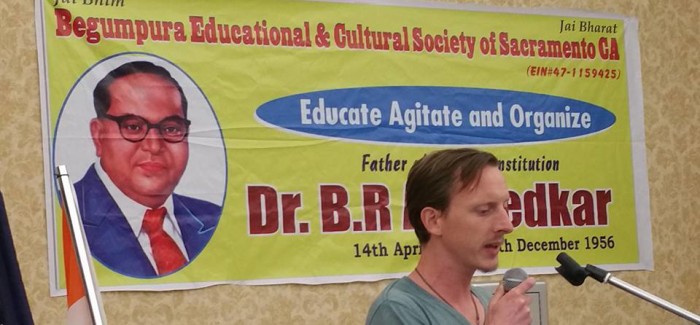Editorial: What if we listened to Dr. Ambedkar?
OFMI advisor Pieter Friedrich presented the following remarks at a July 19 banquet hosted by the Begampura Educational and Cultural Society of Sacramento, CA.
Ladies and Gentlemen —
I am honored at the opportunity to speak in honor of Dr. Bhim Rao Ambedkar Ji’s 124th birthday.
I will not keep you for too long, but I hope to spend a few educational minutes with you.
Dr. Ambedkar was the most influential advocate for recognizing and respecting universal human dignity that India has seen in the past century.
The Indian civil rights movement owes an infinite debt to this passionate and tireless champion.
Perhaps no one did more to expose the religiously and culturally enforced caste system that has shackled India’s downtrodden people for millennia.
As a child, Bhim Rao personally suffered caste discrimination.
Growing up, he was treated by the culture around him as an outcaste.
He experienced the horrors of being viewed as subhuman when he was made to study in a segregated classroom, was forbidden to speak to his teacher or interact with other students, and was forbidden to even share the school’s common water supply.
He knew that the so-called low-castes and outcastes routinely face lynchings, rapes, beatings, and other forms of violence and humiliation simply for breaking the taboo against mixing with other castes.
So Dr. Ambedkar devoted his entire life to pursuing the “Annihilation of Caste,” as he called it.
He burned Manusmriti, the Brahmanical religious law that teaches people are born into division, into four segregated classes of humanity, from superior to inferior. He declared that if caste is to be destroyed, then the Vedas and Shastras (which teach that human beings were created unequal) must also be destroyed. He exposed how caste is the foundation of Brahmanism.
As Dr. Manisha Bangar, of BAMCEF and Mulnivasi Sangh, said when she visited California earlier this year: “Hinduism is nothing but a tool for propagation of caste.”
And so Dr. Ambedkar found some of the best solutions to escaping the spectre of caste are interdining, intermarriage, and, above all, conversion. And he led by example, swearing, “I will not die a Hindu,” and leading millions in conversion to Buddhism.
Today, India desperately needs new leaders like Dr. Ambedkar. The majority of Indians live in grinding poverty, with 723 million Indians living on just two dollars per day — or less. The national Planning Commission “estimated that subsidised foodgrain entitlements will cover 67 per cent of the population,” meaning two out of three Indians lives in such desperate poverty that they depend on the State to provide their daily bread.
Is this poverty any surprise when two out of every three Indians is also legally labeled by the State as low-caste or outcaste — that is, SC, ST, or OBC? In 2011, India conducted the first census to demand caste status since the British Raj fell. And we wonder why the caste system is still so strong?
But Americans often only hear about another Indian, Mohandas Gandhi. They know about him mostly from the Hollywood film, which was co-funded by the Indian State. And they know about him from the dozens of Gandhi statues dotting the United States.
What Americans and many Indians don’t know is that the Indian State pays to install these statues. Between 2001 and 2010, Delhi paid to install nine statues in North America alone and 65 around the world in total. But Gandhi has no connection whatsoever to this country.
Dr. Ambedkar, however, earned a master’s degree at Columbia University in New York City; in 2013, we commemorated the 100th anniversary of his arrival to study in the United States.
Meanwhile, whose picture hangs on the wall of every government office in India? Torture is legal in India, death squads have killed untold thousands, and there are mass graves in several far-flung regions of the country. But the government still calls Gandhi the hero of the oppressed.
The Indian State doesn’t want you to know that, in 1895, Gandhi praised Manusmriti, saying: “The… law, as laid down by Manu, gives some of the qualities needed for the discipline of the mind and reaching the highest Truth.” Or that, in 1932, he said: “Caste is necessary for Christians and Muslims as it has been necessary for Hinduism, and has been its saving grace.” Or that, in 1933, he said: “To abolish caste is to demolish Hinduism.”
The Indian State definitely doesn’t want the world to know that Gandhi used his position of power to become a sexual predator and that his own grandnieces were his victims.
One thing that scares the power-brokers more than anything else is education.
What if people like you and me actually studied Gandhi and Dr. Ambedkar on our own and discovered the real truth?
What if we listened to Dr. Ambedkar?
What if we listened to things like….
His warning in November 1949, when, just days before the passage of independent India’s constitution, he said: “It is quite possible for this new born democracy to retain its form but give place to dictatorship in fact…. If hereafter things go wrong, we will have nobody to blame except ourselves. There is great danger of things going wrong.”
Or his warning in September 1953 when, speaking on the floor of Rajya Sabha, he said: “My friends tell me that I made the Constitution. But I am quite prepared to say that I shall be the first person to burn it out. I do not want it. It does not suit anybody.”
Or his warning in 1955, just one year before he died, when he said: “I always say that, as I met Mr. Gandhi in the capacity of an opponent, I’ve a feeling that I know him better than most other people, because he opened his real fangs to me.”
Let us educate ourselves and learn the truth.
Thank you for your time.

